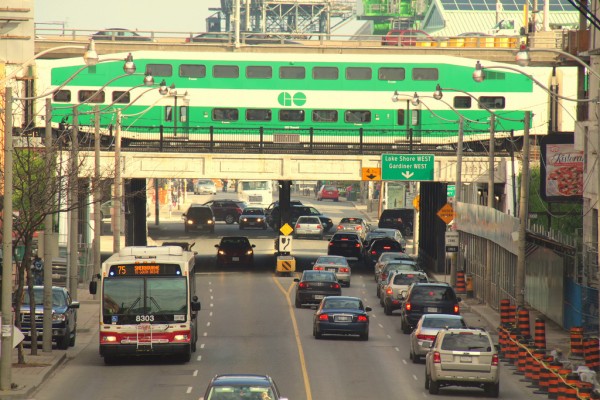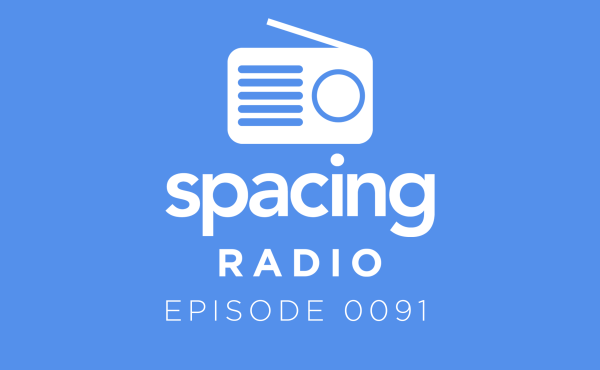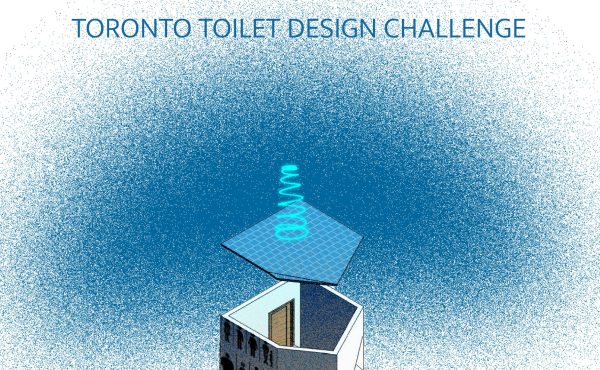
Yesterday morning, Toronto Region Board of Trade (BoT) president Carol Wilding gave every politician in southern Ontario a veritable prairie of leeway by coming out boldly, and with no evidence of prevarication, in favour of four very specific revenue tools — taxes!! — to underwrite a generation of transit expansion in the GTA.
The Board’s well-researched recommendations targeted all the most obdurate constituencies: mall owners (parking levy), drivers (gas tax and high occupancy vehicle toll lanes), and, well, everyone (regional sales tax). Speaking on behalf of the GTA’s most engaged business group, Wilding in effect was saying to all three political parties, but especially those on the right, “We’ve got your back.”
And for that courageous gesture, the Board deserves a lot of praise.
As it happened, there was one, and only one, active politician present at the BoT presser: Trinity-Spadina MP Olivia Chow, the NDP’s transportation critic and, by her own admission, a potential mayoral candidate in a 2014 race against an incumbent who believes subways can be financed with Monopoly money.
Chow, to her credit, has been flogging a no-hope national transit strategy private member’s bill for over a year. So one would think that supporting the Board’s proposals should be a gimme for her.
Well, think again.
What did she think of the specific proposals? “It’s not up to a federal MP to say what needs to be done,” Chow demurred during a scrum after the speech.
What would she say to Premier Kathleen Wynne? I asked. “It’s not up to me to tell the Premier. She’ll make her own decision.”
What does she think of a regional sales tax? “It’s really not up to a federal MP to comment on what the provincial government should or shouldn’t do.”
Excuse me?
I’m not going to pretend that Chow turned up merely to show the flag and chat up Thursday’s federala budget, with its anticipated announcement of a new federal infrastructure program, rumoured to be worth $30 billion. She is meticulously building a case for support, so it was deeply disappointing to see her refuse to take up the political backing that Wilding has generously provided.
Wilding, early on in her remarks, noted trenchantly that the city is not only afflicted by actual gridlock, but also by a gridlock of studies and reports and calls to action that have piled up for literally generations. By 2031, she said, the aggregate cost to the regional in lost productivity will be $15 billion — a horrendous toll. Her point, of course, was that the time has come for our politicians to go out and sell what must seem, to many voters, to be an extremely costly leap of faith.
Yet I’m not sure Chow was listening. What we need now are politicians who are willing put themselves out there because it’s the necessary thing to do.
Wynne, during her leadership bid, certainly had the guts to take a bold stance, running explicitly on the need to bring in new revenue tools to underwrite The Big Move. TTC chair Karen Stintz, who also harbours mayoral ambitions, has been saying for months — and said again yesterday — that the City of Toronto needs to levy its own taxes to build transit.
So it’s not clear to me why Chow was suddenly consumed by a need for intergovernmental decorum. The Harper Tories have never been shy about lecturing the provincial Liberals about their financial management skills. Municipal politicians gripe ceaselessly about the other orders of government. And the MPPs at Queen’s Park routinely rain criticism down on their municipal counterparts.
By speaking out, Chow would be creating space for other politicians, e.g., Andrea Horwath, to align themselves behind the Board’s recommendations and, ultimately, those of Metrolinx, which are due in late May. But by declining to speak out, Chow revealed a troubling lack of leadership and a sense of highly calculated caution at a time when outspoken leadership was never more necessary.
But let’s be honest: we’ve seen this show before. Indeed, on that very point, the release of veteran transit planer Ed Levy’s ebook, “Rapid Transit in Toronto: A Century of Plans, Progress, Politics and Paralysis,” couldn’t possibly be more timely. Levy offers a heart-breaking account of wave after wave of transformative transit visions that were drawn up by forward-looking planners, only to be scuttled by politicians who couldn’t see beyond the next election.
Maybe The Big Move will merely become the next chapter in Levy’s sad story of opportunities missed, squandered or squelched.
If this latest fix is to avoid the fate of its predecessors, Wynne will need a broad coalition of political supporters who have the courage of their convictions and are prepared to talk honestly about specific policies, about the irritation voters will feel at paying additional taxes, and about the light at the other end of the tunnel.
After yesterday’s performance, all I can say is that I hope Olivia Chow takes the time to read Ed Levy’s book — and fully absorb his grave warnings — before she throws her hat into the mayoral ring.
photo by Wylie Poon





16 comments
Hope she reads Levy’s book. He surely talks about St. Jack of Hazelburn opposing the DRL because it would provide developers with an opportunity to build a mature city. Not to mention his complicity in the ignominious Sheppard subway line. Those sleazy back room deals at Metro Hall.
You mention Andrea Horwath, and say that this gives her the opportunity “…to align themselves behind the Board’s recommendations”
Except she does not support any of the reccomendations. Check out her interview on Metro Morning.
“By speaking out, Chow would be creating space for other politicians, e.g., Andrea Horwath, to align themselves behind the Board’s recommendations and, ultimately, those of Metrolinx, which are due in late May” Well, Olivia Chow, doesn’t have to worry about that. If you heard Andrea Horwath on Metromorning, this morning, she’s backing off the Board of Trade recommendations as well.
At this point I don’t know if there’s one politician at any level outside of the Green Party willing to commit to a sustainable transit plan that wasn’t created out of whole cloth and moon beams.
I love how Liberals are looking for the NDP to support tax and spend policies. Wynne is brave but hey make you own bed Liberals and then lie in it.. The voters will light it on fire but hey fortune favours the brave.
I think Olivia Chow is holding back on making critical comments about infrastructure because first, her recent press conference calling for a federal infrastructure fund was not well-received, and second, the GTHA is still at the “general ideas” stage when it comes to new revenue tools.
What this means is that we know we have problems (congestion, gridlock and a massive infrastructure deficit), we have a general idea that we need “new revenue tools” (taxes) … but specific ideas (paying to park at GO stations, added fuel taxes, parking levies) will be shot down quickly.
I would have liked to hear Chow say that as an MP she remained committed to getting more stable funding for infrastructure (and specifically transit) and she looked forward to working with Premier Wynne, Minister of Transport Murray, MPPs and mayors and councillors to create a stable funding plan and roll out these infrastructure projects.
On top of that all-encompassing “spirit of cooperative development” statement, she could also add a comment reflecting her own personal hopes.
We are getting closer to June when plans to fund the Big Move must go to the Cabinet. Now is not the time for timid discussion. We need serious, sober and educated discussion of all reasonable ideas.
And on that note … instead of diluting the effectiveness of HOV lanes by introducing costly tolling that will increase congestion, let’ s expand the HOV network first.
Turn all express lanes on GTA highways into HOV lanes (For buses and carpoolers) and expand GO bus and express bus services on these corridors.
Once we invest in building an HOV network then we can add the HOT option.
In the big picture, I actually think it’s quite appropriate for a Federal MP to sidestep this discussion. Whether or not she might throw her hat into the mayoral race, *right now* she’s a Fed, and the Feds don’t get involved in municipal affairs. That may be a separate egregious sin, but again, it’s not her place.
I think it’s appropriate for Olivia Chow to work on what she can do to get the Feds into reliable funding and less on telling the Province how to raise funds. What’s much more relevant is Ontario NDP leader Andrea Horwath’s views. While I don’t necessarily expect the NDP to be in lockstep with Wynne’s chosen method I’d be very interested in finding out if the party can tap unpaid corporate taxes and how much that and future measures will bring in. I’m worried Horwath’s just coddling drivers.
Many populist politicians believe that winning requires maintaining the status quo – free or heavily subsidized roads & parking while GO, LRT, buses & subways operated, maintained & policed mainly by user fees.
I would not call the BoT report well researched. Unless its goal was to provide its own members with financial gain. The BoT speaks for big business and their wealthy shareholders only. Demonstrated by its dismissal of income taxes.
Horwath is every bit of a fraud no substance populist as Ford and Hudak. Seizing on auto insurance rates and fare freezes as the solution to all of our problems? Really?!
@sal morejo: Jack Layton probably opposed the DRL (as I do) because it will most likely destroy and disrupt the neighborhoods that it will be built in and run under, and is just ‘troglodyte transportation’ as city Councillor Gord Perks put it when he wrote about environmental issues in Eye Weekly. All that we really need is Transit City built the way that it was supposed to be, with the Waterfront LRT line being one of the lines serving the core of the city and the Eglington Crosstown line being the other. We don’t need to be building a relief line that will end up having problems because a house has to be torn down to make way for a emergency exit (as happened last year when the TTC ran into opposition removing houses to build emergency exits for the Bloor-Danforth line’s Coxwell & Greenwood stations) and we don’t need to be reinforcing the car and the bus at the expense of public transit (which is what subways do) nor do we need to be always having to descend into a cave to ride a train for a couple of blocks to get to a destination just because that’s what’s always been done in Toronto since when ever.
Sadly, what Jack and other progressives wanted in life will never be accomplished due to people being trapped in the past and always doing things ‘just because’.
Olivia Chow has just taken herself out of serious consideration to be mayor by not showing leadership on transit issues. And Andrea Horvath is entirely missing in action from the transportation file.
@Simon Tarses
I think you’re blowing the potential effects of the DRL out of proportion. In New York, they have been building a new subway line down Second Avenue in Manhattan for more than 10 years. While some people have been relocated due to construction, the neighbourhoods through which construction has proceeded remain vital and intact. We could do the same here for the DRL.
As for whether we need the DRL or not, I suspect we do. The Waterfront LRT and Eglinton Crosstown lines would serve east-west commuters bordering the lake and midtown respectively, they would not serve the same north-south capacity as the DRL. If you look at the original Transit City map, you’ll see a Don Mills LRT line that follows approximately the same trajectory from Eglinton to Sheppard. I think it’s well accepted that people from the eastern parts of the city take transit west to the Yonge line, and then go south; the DRL would allow them to make that trip faster, and allow all other users of the Yonge line to ride without feeling like a sardine in a can. I’m confident in deferring to city staff and Metrolinx as to whether we need it or not. They have the planning expertise, they have the demographic data, they have 30+ years of commute pattern data, and if they all conclude we should have a DRL lest the Yonge line be rendered ineffective due to massive congestion, then I believe them.
Throw in something for Hamilton and Andrea will get on board.
@Simon Tarses, I think it’s quite clear based on your comment that you don’t use the Yonge subway during rush hours. You also seem to be a bit confused with regard to the geography of our city. Yonge and Eglinton is not “the core”, and while an Eglinton LRT will certainly be useful, all it will do is put even more pressure on the already over-capacity Yonge line; it will do nothing to provide more capacity into the core. As for the Waterfront LRT, it would help, for sure, but nowhere near what’s needed and it would not address the most pressing need today, which is more service to the core from the north-eastern part of the city. We simply can’t keep funneling more people onto the Yonge line.
said by Leo G:
“We simply can’t keep funneling more people onto the Yonge line.”
Hasn’t that been official TTC policy for years now? That’s why we have the new Toronto Rocket trains with open gangways and more room, that’s why the Yonge line will have automatic train control, and that’s why there are even proposals to squeeze a small 7th car into the Toronto Rockets. Because it’s perceived as cheaper to keep stuffing people into one corridor instead of building another one, service quality and rider comfort be damned.
You do not want at-grade/surface level LRT on Eglinton. Just impractical for the sheer volume of travel use by car drivers at intersections and people on an LRT…it will slow down the train compared to subway train speeds and frequency.
Guaranteed. I lived and worked in Toronto for 20+ years. Travelled the Eglinton St. E. for over 6 yrs…and that was awhile ago by bus (transfer to subway. etc.)
Now in Calgary where it is primarily LRT at surface, it is by comparison just slower, less frequent. The constant stopping at road traffic intersections, etc. Think of it this way: no different than cycling on the road with all traffic intersections, …when you are not on a bike-ped path in Don River Valley, Taylor Creek, etc. cycling home from downtown to Scarborough…which is what I used to do as a commuter for 14 yrs. (by Victoria park station)